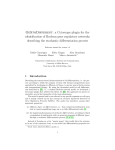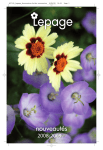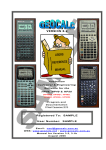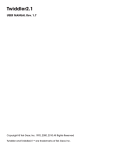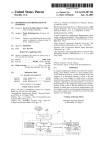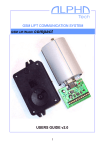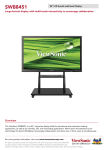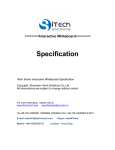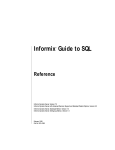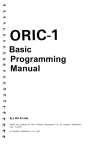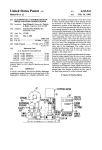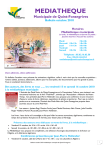Download Search/retrieval system
Transcript
USO0RE36653E
United States Patent [19]
[11] E
Heckel et al.
[45] Reissued Date of Patent:
[54]
[76]
SEARCH/RETRIEVAL SYSTEM
4,412,294
Inventors: Paul C. Heckel, 146 Main St., Suite
404, Los Altos, Calif. 94022; Charles
H. Clanton, 220 DoWney St., San
Francisco, Calif. 94177
Re. 36,653
Patent Number:
Apr. 11, 2000
10/1983 Watts et al. ........................... .. 707/529
4,417,322
11/1983
4,418,345
11/1983 Demke et al. ..
Berry et al.
.....
. . . ..
707/523
345/27
4,428,065
1/1984 Duvall et al.
4,429,372
4,430,725
1/1984 Berry et al. ........................... .. 707/508
2/1984 Elliott et al. .......................... .. 707/511
707/7
(List continued on neXt page.)
[21] Appl. No.: 07/504,679
[22] Filed:
Apr. 4, 1990
OTHER PUBLICATIONS
Macintosh (TM), Apple Computer, Inc., pp. 1—8, 20—34,
50—61, 82—84, 91—92, and 155—160, 1983.
Related US. Patent Documents
TimeWorks ‘SWiftCalc ST’ User’s Manual, pp. 55—57, 67,
68, 78—80, 1982.
Todd ‘Abbreviated Typing for Word Processing’, 2BM
TDB, vol. 21, No. 9, pp. 3796—3797, Feb. 1979.
Bringol ‘Abbreviated Character Font Display’, 2BM TDB,
vol. 19, No. 9, pp. 3248—3249, Feb. 1977.
Reissue of:
[64]
Patent No.:
Issued:
Appl. No.:
Filed:
US. Applications:
4,736,308
Apr. 5, 1988
06/754,512
Jul. 10, 1985
(List continued on neXt page.)
[63]
Continuation-in-part of application No. 06/647,649, Sep. 6,
1984, abandoned.
[51]
Int. Cl.7 ...................................................... .. G06F 3/14
[52]
US. Cl. ........................ .. 345/340; 345/123; 345/131;
[58]
Field of Search ................................... .. 364/521, 200,
345/419; 345/435; 348/107; 707/507; 707/508
364/900, 518, 340/721, 723, 724, 726;
395/100, 118, 144, 145, 146, 148, 149,
153, 155, 157, 158, 600; 345/115, 116,
119, 120, 123, 127
[56]
U.S. PATENT DOCUMENTS
4/1983
Sukonick et al. ....................... .. 345/24
3,757,037
9/1973
Bialek ............ ..
3,792,462
2/1974 Casey et al.
12/1980
Bringol
........
4,386,410
Attorney, Agent, or Firm—Steven Lundberg
[57]
ABSTRACT
A computer program provides for the display of selected
portions of tWo or more records on a display screen Where
the portions selected are from different records, and may be
from different ?les. Provision is made for scrolling of the
full text of the displayed records, Which may be grouped by
Alternatively one of the tWo or more records may be
Re. 31,200
4,240,075
Assistant Examiner—Chien Yuan
common subject matter.
References Cited
4,366,475 12/1982 Kishi et al.
Primary Examiner—Thomas C. Lee
348/107
340/726
. . . . ..
345/25
displayed on the full screen With the capability for selec
tively switching betWeen the single record and tWo or more
records or a display shoWing portions of more than one
record from more than one ?le.
345/131
5/1983 Pandya et al. ........................ .. 707/531
96 Claims, 14 Drawing Sheets
I4
/
I
50
60
I
2
e
ff
25
k
l I
l
q
r r
r
w
xx
6
7
8
f
x
9
I‘?
cc udod
ud
Re. 36,653
Page 2
US. PATENT DOCUMENTS
4,653,020
3/1987 Cheselka et al. ..................... .. 345/344
4,692,757
477007320
9/1987 Tsuhara et al. ....................... .. 345/116
1O/1987 Kapur _____ __
345/344
4,434,475
2/1984 McCaskill et al. ................... .. 345/352
4,435,777
3/1984 McCaskill et al.
. 707/531
477107762 12/1987 Yamada
345507
4,435,778
3/1984 Cason et al. .... ..
. 707/509
477557809
345/34O
-
4,459,678 7/1984 Mccaskill 9t 91
4,481,603 11/1984 McCaskill et al.
4,486,857
12/1984
Heckel ------------ -~
4,495,600
1/1985 Kllfuchletal-
4,506,343
4,507,753
4,538,183
4,542,376
3/1985
3/1985
8/1985
9/1985
345/326
4,791,561
. 707/507
478057099
2/1989 Huber
- 707/508
4,823,108
4/1989
- 712/300
4,870,611
9/1989 Martin etal. ......................... .. 707/526
4,872,001
4,888,690
4,947,370
10/1989 Netter ..... ..
345/340
12/1989 Huber ........................................ .. 707/4
8/1990 Sugitani .................................. .. 400/63
ShIPP, Jr- et al- Mccaskill 9t 91Kanno etal- ------------------------- -Bass et al. ............................ ..
707/509
707/508
358/452
345/340
4,550,315
10/1985 Bass et al.
. 345/199
4,555,759
11/1985
. 707/531
McCaskill et al.
7/1988 Ikegami et a1_
12/1988
Huber
.......
. . . . . ..
707/1
7O7/1O2
Pope ...................................... .. 345/340
OTHER PUBLICATIONS
_
4,586,035
4/1986 Baker et al. .... ..
. 345/157
DB Master Personal Computer Program manual copyrlghted
4,591,840
4,616,327
4,618,858
4,633,415
476337430
5/1986 Curtis et a1, ____ __
10/1986 Rosewarne et al.
_ 345/156
. 345/435
1980 by Barney Stone and Alpine Software, published by
StoneWare. pp. 11—21, 58—63.
10/1986 Belch ...................................... .. 345/28
Apple Works Made Easy Carole Boggs Matthews published
12/1986 Vmk et al. ............................ .. 345/123
12/1986 C901)“ ~~~~~~~~~ ~~
4,642,790 2/1987 MlIlShllll et al.
4,645,238
4,646,250
476497377
4,649,499
4,649,513
2/1987
2/1987
3/1987
3/1987
3/1987
- 707/500
. 345/341
by Osborne MCGraW_H?1 Copyright 199()_ pp 97_137_
Lisalist copyright 1983, Apple Computer. Page Column B,
Chapter 1 and Section C, Chapter 1'
Vincent et al.
283/67
Childress
. 707/507
Urabe _______ __
_ 345/118
Sutton et al. ......................... .. 345/419
S
.t
. ht 1982 1984 th C
.t M
611"” coPyng
> _
e Ommum y
emory
Pro]ectPubl1shed by Golernics Inc., Berkeley, CA Section 2.
Visicalc Est' 1978 a Conventional Spread Sheet program pp
Martin et al. ......................... .. 707/526
1—1 through 1—7, 2—8 through 2—12 and 3—2 through 3—4.
U.S. Patent
Apr. 11,2000
Sheet 1 0f 14
Re. 36,653
MLQDQE
ii;>930non~NM08uuo8v0a
I\...
.liQ1.
2w
L
v;a__xI3_. |
L
WAS
N
¢
w
o
..9
on
8
.
No-a-UuEm»
.Q\@
M
mm
u
Inn
n
LL
L
Q--oummm0.I
llmmm3LLLxx>>>>|Iux
a _ .lM
mE-aLLLwcaQ.IElc:.l m |nc L»::LM
U.S. Patent
MAI
'-°°P
N
Apr. 11,2000
IgLIJ-RGIZIRZDE
CURCOL
V
Sheet 2 0f 14
'
Y’Am?m.
CH
Re. 36,653
F'6 UR E 2
no
lNlgUT
RE
CHAR
DISPLA
yes
24
.Yes
no
32
CURCOL
B
AST COL
yes
"°
,
cu RCOLI
CURCOL+I
_ ADJ
MAIN
LOOP
no
CURCOLI
CURCOL-l
-_
ADJUST
MAIN
cuacao:
—I-AoJus
CUR CRD -|
no
30
CURCRD =
cuncno + .|
no
yes
MAIN
42
DATA
LOOP
“""JJUST
U.S. Patent
ADD
Apr. 11,2000
Sheet 3 0f 14
FIELD
Re. 36,653
STORE COL
TO DISPLAYED
CARDS
I
no
H
EXPAND
433
C:
CUR coL
TO FULL DISPLAY
FULLCARD
I‘—_
yes
"0
C=H
‘I
STORE ALL
(25:22?
scRoLLme
FARMS
: o
PERFORM
EDIT
ADD FIELD
LABEL T0
EXPAND
cuR CARD TO
x ANCHOR
(CUR COL)
FUNCTIONS
CURRENT FIELD
FULL DISPLAY
: o
MAIN
LOOP
SCROLL FULL
Y ANCHOR
FIELD
THROEUSH
ALLOCAT
)écggccgggo
°UR=C°L
(CURCOL)=O
DSP “"07"
FIELD SIZE
Y
PERFORM
MAIN
CUR=COL
ED"
KO?
osp WIDTH
FUNCTIONS
CURCRD HGT
DSP HGT
PERFORM
EDIT
FUNCTIONS
CH
:1
ULLCAR
FIGURE 24
RESTORE
PARMS
MAIN
LOOP
FARMS
M
II
MAIN
LOOP
U.S. Patent
Apr. 11,2000
Sheet 4 0f 14
Start
Re. 36,653
with full column
ADD
A
COL
yes
446
‘
COLS
DIS PLAYED
coLs
DISPLAYED +|
I
N = O
coLIIvIDTH
DISPLAY WIDTH
-_-—>.‘
coLs DIsPLAYED
N=N+|
SORT
/ 445
REQUESTED
‘
COLUMN
XANCHOR
COL NO (I)
1'
C)é)tNN%H(%i;?_
III-0*
DISPLAY WIDTH
F“"“
I
DISPLAY
‘I
V447
|REQUESTED |
L°2E°E?~ij
{
HIGHLIGHT
CURRENT
COLN_O(N)
coLs DIs~
PLAYED
COLUMN
___i___?
DISPLAY
COLUMN
NUMBERS
___
FIGURE 25
I
I/448
l
_.____l
U.S. Patent
Apr. 11, 2000
FUNCTION
SET
PARM
SET PARAMS
Sheet 5 0f 14
Re. 36,653
/44
(ARGUMENTS)
i
CARD HEIGHT
NON-CURRENT
LINES
/46
i
COLWIDTH=
NON-CURRENT
CARD WIDTH
/48
(COLUM N S )
i
CUR RENT
CARD WIDTH=
CURRENT CRD
MAX WIDTH
/5O
i
CURRENT CARD
HELGHT
CURRENT CARD
LINES
/52
4O
FUNCTION
ADJUST
54
ANCR
( CU RCOL.)
+ CURCOL WIDTH
X ANCHOR
(CURCOL)'
DSP WI DTH
COLWIDTH
56
X ANCHOR
x ANCH o R
(CUR<COL)
(CURCOL)
I
O
FIGURE 3
Y ANCHOR
(CURCOL)'
DSP HEIGHT
"CURCRD HEIGHT
U.S. Patent
Apr. 11,2000
Sheet 6 0f 14
Re. 36,653
60
Y ANCHOR
Y ANCHOR
(CURCOL)
(CURCOL)
(0
I 0
CL FST DSP CARD(CURCOL) ,
CURCARD' YANCHOR‘CURCOL)
OL l N E S
i
COLNO =
CURCOL- I
FIGURE 4
X ANCHOE‘COLNO)
x ANCHOMCOLNOH)
- COL WIDTH
64
x ANCHOR
XANCHOR (BCURCOL'I' I)
(COLNO)
X ANCHOR‘CURCOL)
COL WIDTH
FRST DSP COLNO
-
I
CC LNO
i
COLNO
COLNO-l
U.S. Patent
Apr. 11, 2000
Re. 36,653
Sheet 7 0f 14
COLNO =
61%
FUNCTION
CURCOL'I' 2
PLAY
REDISPLAY
i
XANCHOFNCOLNO)
=X ANCHOR
COLNO =
FRST DSP COLNO
(COLNO'I) 'l'
COL WIDTH
/72
VD WIDTH=
COL WIDTH
VD HEIGH T=
CARD HEIGHT
78
LST DSP COLNO
S
COLNO
i
COLNO
y
95
CURCOL
DO
COLNO =
COLNO + I
XORG=
x ANCHOR(COLNO)
Y ORG = |
FIGURE 5
FIGURE 6
VD WIDTH 8
CCOL WIDTH
U.S. Patent
Apr. 11, 2000
Re. 36,653
Sheet 8 0f 14
MAIN
LOOP
FIGURE 7
v cARo :
cLFsT DSP can -
(COLNO)
v HEIGHTI
Yes
scum -
CURCRD HEIGHT
scHEMMv CRO
(COLNO)?
scum
9O
SCHEMA
(couoo)
RETRIEVE AND
(vYORG,VDWIDT'H,
‘ékso‘itél?‘i8m
""" 92
VHGT.,SCHM )
YORG -
Y one +
v HEIGHT
/ 74
es
y
COIINO
co1_~o+ |
no
76
yes
v CARD =
MAIN
v CARD + |
LOOP
no
A
U.S. Patent
Apr. 11,2000
u
n
u
_
.
Re. 36,653
~
n
Z1 1 1a:
1a
1
“
TE
111112;
111
Y;19?.‘
1111
5
_.w
Z»_N
__ n
_
m
Sheet 14 0f 14
"
coo
111|1can
I1|1lI
“see11111155s1
Il1|1|1 111L
I|ilIl|IIlIlIlI|lIIl
rl
‘IlIl|Il1Il|IlIIJ
II|llIl|
6Om?
_
“
2:01uHws<zv
mZIHO1S< Om_ZI1NMS<
zhomxw.n
_
.
_
L_________________________.__
__
cu
10
q
10
L0
h
co
m
9
_
QMQDaQI
_
_
_
_
_
Re. 36,653
1
2
The result of the present technology is that While portions
SEARCH/RETRIEVAL SYSTEM
of multiple records may be concurrently displayed on a
display device, unabbreviated portions are selected sequen
tially as they appear in the record and not by the intelligence
contained in the ?elds.
Matter enclosed in heavy brackets [ ] appears in the
original patent but forms no part of this reissue speci?
cation; matter printed in italics indicates the additions
made by reissue.
This is a continuation-in-part of application Ser. No.
647,649, noW abandoned, ?led Sept. 6, 1987.
SUMMARY OF THE INVENTION
DESCRIPTION
a method of simultaneously displaying selected portions of
This invention relates to searching for and subsequent
display of portions of various data ?elds in stored records.
In particular, it relates to display devices Which have limited
display capability but Where information to be displayed is
It is a further object to provide for the scanning of adjacent
records or ?les While retaining the limited displayed portions
of the adjacent or juxtaposed records.
This invention is for a computerized data system having
It is an object of this invention to provide means for and
1. Technical Field
from several records and Where the amount of information
different records from one or more ?les stored in a computer.
15
a data string input device, a processor, a storage device for
may exceed the display siZe.
2. Background of the Invention
The data processing ?eld has noW reached the point Where
portable computing is available in relatively small sizes. In
storing independent strings of data, each of variable length,
With each string having several ?elds. The independent
strings may be classi?able into groups With each group
having strings With at least one similar ?eld. The invention
also includes an output device having a limited display
particular, computers With a relatively large storage capacity
are available With dimensions not much larger than a piece
of typing paper and that Will conveniently ?t into an attache
case and operate from battery poWer. While this invention is
addressed to these small portable computers, it is equally
applicable to the non-portable or larger siZe computers. The
impetus for the invention is the lack of search and retrieval
systems Wherein selected portions of more than one record
can be displayed concurrently.
“WindoWing,” a capability available With some operating
capability. The data retrieval and display system comprises
means for locating each stored string of data and means for
25
simultaneously displaying on the output device preselected
portions of a ?rst independent string and preselected por
tions of a second independent string. The ?rst and second
strings may be from different groups. The secod string
preselected portions have a display length less than the
displayed length of the ?rst string preselected portions.
systems, enables a user to display at least portions of more
This invention overcomes the failure of the earlier devices
than one record or portions of a large record (e.g., a matrix)
in a format selected from and controlled by the operating
system on a single video display device. Usually, one
formatted record is overlayed upon another formatted record
so that portions of intelligence may be lost. Since the
by providing simultaneous display of different preselected
portions of various data strings contained in one or more
?les stored in a computer.
35
associated operating system is usually controlling in a
FIG. 1 is an illustration of the relation of the display to the
“Window” situation, a user may be able to operate on the
data portions of the record, and then to the ?le, and ?nally
displayed data, e.g., make changes. The Window concept
usually does not provide for shorter or abbreviated data
?elds Within a record. Consequently because of the siZe
parameters of the requested Window incomplete and in some
cases unintelligible information is shoWn.
In addition to the shortfall of WindoWing, the small
tablet-size computer usually has a limited display space.
Speci?cally, this display space may alloW for ten to ?fteen
roWs of information With each roW containing ?fty to
to a composite group of ?les.
FIGS. 2, 2a, 2b, 3, 4, 5, 6 and 7 are How charts of a
representative program that operate this scheme.
FIG. 8 is a representative record layout.
45
FIG. 11 is a similar change in the display representation
after a second parameter change.
FIGS. 12, 13, 14 and 15 are similar changes in the display
set forth above, if one Were to display tWo or more records
at one time, the ?fteen by seventy-?ve character display area
must be divided in some proportion. Without a proper
representation after subsequent parameter changes.
schema to display the individual records, the records Will be
truncated by the amount of available display space.
FIG. 16 is a single record representation.
FIG. 17 is a representation of several records each on a
US. Pat. No. 4,486,857 issued on Dec. 4, 1984 to Paul
single line.
55
data ?elds such that voWels may be removed from names,
streets, cities and the like, thus reducing the display require
ments for particular records. For example, the names
“Smith” may be abbreviated to “Smth.” This capability,
While serving the function set forth in the earlier application,
DETAILED DESCRIPTION OF THE
PREFERRED EMBODIMENT
have the capability for selective display of data ?elds Within
a particular record, but rather gives sequential display of all
This invention deals With the concurrent display of por
tions of several records from separate ?les stored in a
the data ?elds. That is to say, While the various ?elds may
“perused.”
FIG. 18 is a representation of the “scrolling” feature of
this invention.
FIG. 19 is a representation of the ?rst tWo columns of the
display in FIG. 1 With column headings and blank lines.
is limited to a single record at a time, and further does not
be abbreviated by removal of certain characters, all of the
?elds are sequentially displayed When the entire record is
FIG. 9 is a representation of the multiple ?le structure.
FIG. 10 is a representation of the display shoWn in FIG.
1 after an adjustment has been made to the record/?le/?les
parameters.
seventy-?ve characters. Thus, in the WindoWing examples
Heckel, the inventor herein, and assigned to QuickvieW
Partners of Los Altos, Calif. provides for compression of
BRIEF DESCRIPTION OF THE DRAWINGS
65
relatively small microprocessor.
In order to better understand the description that folloWs,
one should understand that conventional terms are used to
Re. 36,653
3
4
refer to the data being manipulated and displayed. This data
It may also be appropriate to include movement of ?elds
Within the record. Similar to the record movement, ?eld
movement may reorder all the records in the ?le.
The schema in addition to the data description includes, as
the “vieWboard,” the height of the record, or the number of
Will be considered to be ordered to the extent that there are
tWo or more ?les Where each ?le is an organized collection
of records. Each record consists of an independent data
string of one or more data elements or ?elds. In the particular
embodiment discussed beloW, the system can be compared
lines as indicated in FIG. 8 and shoWn as “r” in the
to a series of racks such as is seen adjacent a time clock.
representation in FIG. 8. It also contains the Width “s” as
shoWn in FIG. 8. The total length of the record, or more
Each rack is comparable to a ?le With each rack or ?le
associated With a division or department. Each record is
comparable to an individual time card. The elements of
information on each time card such as name, address, pay
rate, etc. are comparable to the data elements or ?elds.
properly the string of data elements or ?elds, While variable,
is alWays less than some value “t.” Finally the schema is the
record description. If all the records in one ?le contain
similar ?elds then a ?le or rack schema is all that is
necessary. However, since variations Within a ?le are per
Hereinafter the terms ?le, record, and ?eld Will generally be
used in the context set forth above. When referring to the
“rack/card” analogy, reference may be made to a column to
signify a “rack” or ?le and to roW to indicate the positioning
of “card” or record in the ?le.
In FIG. 1, the composite ?le structure is indicated at 10,
While an individual record (card) is indicated at 12, and the
15
schema may also include information as to the order and
position that individual ?elds Will be displayed. Speci?cally,
the display line may be speci?ed in the schema for each
?elds. This Will become clearer in the subsequent discus
sion. Hereinafter “line” Will sometimes refer to the display
display of selected portions (?elds) of record 12 along With
selected portions of other records are indicated at 14. Com
of data on a video display device.
posite ?le structure 10 is comprised of a plurality of records
that by appropriate classi?cation could be formed into an
In the event the intelligence that is contained in the record
is not in character format, the display lines and columns may
m><n matrix. Where there are n ?les and up to m records in
each ?le (see FIG. 9). While the matrix format is used in this
speci?cation, it is to be understood that the actual storage of
mitted an individual record schema may be used. Reordering
of the record may, of course, change the schema. The
be considered as a number of pixels in each line and column.
25
the individual records Within an individual microprocessor
or storage unit associated With a computer Would not nec
essarily be in matrix format. A matrix format is chosen
simply because the structure of the various ?les is such that
the individual records in certain ?les can be classi?ed by at
For convenience, in this speci?cation, a character Will be
considered as a single pixel. Other measurement units could
just as Well be used.
The vieWboard indicates hoW the data contained in the
record is to be displayed Within a rectangle equal to or less
than r lines and s columns, Where r and s are equal to or less
than the screen display siZe as expressed in pixels. It should
be understood that other means of display than the line
least one data element of common subject matter. The matrix
format also represents mathematically the metaphoric rack/
column relationship could be used.
card concept previously discussed. One can consider that
there are n ?les With up to as many as m individual records 35
Associated With a ?le or column schema is an index of
in each ?le (column). Referring to FIG. 8, the individual
record itself may be composed of “r” lines of data lines
records contained in the ?le. The index also contains an
Where each line may contain up to s characters or pixels (the
on the screen. For example, in FIG. 1, a portion of record ‘a’
Width). More Will be said about the record layout subse
is displayed in the ?rst column and ?rst line of display 14.
quently. In FIG. 9, it can be seen that each individual
“column” or ?le need not necessarily have m records. In
FIG. 9, the records are represented in the familiar roW matrix
It can be seen from the ?le matrix 10 that this record is in
roW 3, and column 2. In addition to the ?rst record to be
displayed, the ?le schema may also designate a current
record in the ?le for the ?le or column. In the example
shoWn in FIG. 1, record “0” is the current record in the
fourth ?le. Finally, the ?le or column schema contains the
display coordinates of the current record or string. These
coordinates Will be referred to as the “X” anchor (xth
indication of the ?rst record that is normally to be displayed
format, 1,1; 2,1; 3,1 Wherein the ?rst numeral represents the
sequential record or roW and the second numeral, indicates
the ?le number or column When using the roW column
45
matrix convention. Referring again to FIG. 1, record 12 is
the fourth record from the fourth ?le.
Each record, as indicated in FIG. 8, contains intelligence
normally in a character format that Would normally be
divided into different ?elds. However, it is conceivable that
column) and the “Y” anchor (yth line). In the example
shoWn in FIG. 1, the “X” anchor and “Y” anchor is indicated
at numeral 16.
In FIG. 1, for the 11 roW by 61 column display, the “X”
anchor is at “X” coordinate 22, and the “Y” anchor is at “Y”
coordinate 5 Wherein the “X” coordinates read from left to
the intelligence may be stored in some other form such as an
ideographic or pictorial representation or the intelligence
may be in free form rather than divided into ?elds so that a
record can be composed of several roWs of text such as a
document.
Associated With each record is a schema 92 Which may be
unique to the record or Which may be common to the ?le.
The schema describes the data or intelligence (eg the ?eld
names) that is contained in the record and a vieW mechanism
or “vieWboard” that describes hoW the data is to be dis
played.
It is to be understood at this point that the records and ?les
may be ordered and further that the ordering can be modi?ed
at Will so that records Will be “moved” in the ?le and further
55
right and the “Y” coordinates read from the top doWn. These
coordinates are repeated in FIGS. 10 through 15.
It should be understood that a record in a particular ?le
could constitute the list of records in that ?le and further
could contain the information that is denoted above as the
schema. It should also be understood that each record can be
analogiZed to a card With certain information contained
therein. Such cards could constitute address cards or
appointment cards or the like.
Referring again to FIG. 1, the display device 14 can be
considered as a vieWing board on Which portions 18 or all of
may be moved to a neW or different ?le. Movement of a 65 a record 12 may be displayed (assuming the record does not
record Will re-order the ?le. Conveniently the order may be
exceed the display siZe). The display area has associated
alphabetical by any desired ?eld.
With it a series of parameters, referred to as the vieWboard,
Re. 36,653
5
6
that determine hoW the various records are to be presented
on the display device 14. For example, a current ?le or
column or group is contained therein. In addition, the height
of the display and the Width of the display are also contained
the liquid crystal type, a cathode ray tube, or some other
in the vieWboard. In FIG. 1, the height of the display is
sufficient to display eleven lines of characters, and sixty-one
multi-?le display, particularly those indicated in the block in
columns of characters. The Width in Which a ?le or portions
of a ?le may be displayed is also a portion of the vieWboard.
This is referred to as the column Width. In the example given
in FIG. 1, the column Width is ten characters or pixels. Each
appropriate display device.
At the time the system is turned on, the user may be given
an option to initialize the vieWboard parameters for a
FIG. 2. Alternatively, the ?rst ?le is shoWn in the manner of
FIG. 17, With one line from the ?rst several records.
The parameters for a multi-?le display include the current
card or record, the current column or ?le, the “X” anchor and
10
record height is also given in the parameters. In FIG. 1, the
record height is one line.
continuous perpetual loop denoted “main loop” at the entry
In addition to giving the standard record height, the
arroW 22 in FIG. 2. This main loop is continuous and is
entered upon the sensing of one of a set of particular
current column may be expanded to display a larger area
than the adjacent column. This is shoWn in FIG. 11, Where
15
the current column or third column has a Width of thirty
characters, While retaining the one character height.
The current record height may also be expanded to shoW
characters, such as a right arroW; a left arroW; an up arroW;
a doWn arroW; or a command to reset the parameters. It also
recognizes certain display parameters such as a full column
presentation, a full record presentation or a scrolling of an
individual ?eld. If some other character is sensed the pro
gram Will enter a data manipulation or maintenance subrou
tine. If no character is sensed, the system is directed to a
more information. This is illustrated in FIG. 14, Wherein the
current column is 30 characters or pixels Wide and the
current card (in FIG. 14, this is the “t” record) is four pixels
high, While the remaining records are tWo pixels both in the
current column and the displayed columns adjacent to the
current column. It Will be seen that these parameters may be
changed by the user With the only restriction on the user
being the actual video display area as indicated in FIG. 1.
“Y” anchor and other parameters such as the display height,
the display Width, and the like. The program then enters a
redisplay function. As previously noted, it may be appro
priate to select a default set of parameters so that at start up
time the full column presentation shoWn in FIG. 17 Will
25
appear. Subsequent change of parameters Will provide the
display shoWn at 14 in for example FIG. 1.
Should the user so Wish, either a single column With its m
As Will be seen, the arroW commands Will move from one
records can be displayed With, for example, only one line per
record to the next adjacent record depending upon the
record or card shoWing. Of course, more lines can be
direction indicated by the arroW as shoWn in the decision
displayed (See FIGS. 16 and 17). Similarly a single record
blocks 24, 26, 28 and 30. Should the shift in the current
or card may be displayed in the entire screen With the only
record/card or column/?le exceed the number of cards or
limitation being the actual display siZe (see FIG. 16).
columns, as indicated by the second series of decision blocks
32, 34, 36 and 38, the program returns to the main loop
Without further action. HoWever, if the action is permissible,
that is, there are still undisplayed ?les/columns or undis
played cards/records, then the current ?le/column is indexed
Acapability to shift from the multi-?le display as shoWn
in FIG. 14 to the single ?le display as shoWn in FIG. 17 and
?nally to the single record as shoWn in FIG. 16 gives one the
capability to rapidly Zoom in on the explicit detail contained
in a speci?c record. Conversely one can ?guratively back
aWay from the single record detail to the FIG. 14 multi-?le
35
accordingly and the program jumps to the “adjust” function
40 in FIG. 3.
If, on the other hand, the character sensed in the main loop
as shoWn in FIG. 2 indicates a change in parameters (i.e., the
vieWboard), then the decision block 42 Will shift the pro
display With usually a single command or key-stroke. This
capability can be compared to a Zoom lens on a camera
Where one gets either a detail look or a broad vieW. It differs
form the Well knoWn “Window” in that the instant invention
provides the “magni?cation” of a Zoom lens While a “Win
doW” overlays a different portion of the detailed vieW
gram to the “set params” function 44 (FIG. 3) Which is
45
Without the “magni?cation.”
alWays immediately folloWed by the “adjust” function 40
just mentioned.
Finally, When displaying several cards or records in the
multi-?eld mode Where the ?elds Would normally be abbre
viated as taught in US. Pat. No. 4,486,857, the unabbrevi
If some other character is sensed decision block 43 (FIG.
2) Will shift operation to a data loop subroutine shoWn in
FIG. 2a. In addition to the usual edit and data manipulation
functions Which are Well knoWn, this data loop subroutine
ated ?eld along With its label can be scrolled cross the screen
so that the user can “see” the full ?eld. For example a
provides for full screen display of portions of one group or
?ctitious organiZation, “Johnson Machine Works” may be
the full name While the abbreviated name 450 (see FIG. 18)
at decision block 431. Decision block 432 Will display ?eld
labels, While decision block 433 Will display a full record or
card. Decision block 434 Will “scroll” a ?eld name and the
data in that ?eld across the abbreviated ?eld siZe as shoWn
in FIG. 18. If the ansWer to all the decisions 431—434 is no,
then the edit functions are performed before returning to the
?le (i.e. each record portion extends across the full display)
Would be “Jhn Mchn W” in a ten character ?eld. When
“scrolling” is selected the ?eld name 452, in this case 55
NAME and JOHNSON MACHINE WORKS Will appear
sequentially moving across the display area in the 10 char
acter ?eld as shoWn. The Roman numerals I, II, III, IV and
Main Loop (FIG. 2). In all of these situations the vieWboard
V shoW the name as it moves across the ?eld.
parameters (Which are discussed in the next paragraph) are
stored until the display is returned to the default condition as
THE PROGRAM
FIGS. 2 through 6 illustrate the logic associated With the
operation of video search and retrieval systems. It is to be
assumed that the display device 14 has an underlying
operating system that provides the necessary program func
tions to display characters and the like on the screen asso
ciated With the display device. The screen may be either of
shoWn in FIG. 1 unless the default is set at a full column
display (FIG. 16 or 17). It is pointed out that the full column
displayed Will be the current column and the full card
displayed Will be the current card. As can be seen from the
65
How chart (FIG. 2 and 2a) one can readily sWitch from the
multi record display to the single column or card display and
back again With only one key stroke.
Re. 36,653
8
7
for another input character, if another character is sensed,
The “set params” function 44 accepts at least four param
eters from the user Which determine the display area for the
various records and ?les displayed on device 14. In the
then the routine just discussed Would be re-executed. In
addition to rearrangement of the broad display, the user can,
present invention, the parameters accepted include noncur
rent lines or “roWs” 46 (see FIG. 3). Referring to FIG. 1, the
as indicated above, select a “Wide screen” or “Zoom” for
either a single ?le or column or a single record or card.
noncurrent roWs Would be the roWs or records displayed for
all but the third column of ?les or cards. Each record or card
However, if no character is sensed as coming from the input
device, then the redisplay function 70 shoWn in FIG. 6 is
is shoWn only on one line in FIG. 1. The second parameter
performed.
accepted is the noncurrent column Width 48 (see FIG. 3). In
the example shoWn in FIG. 1, this Would again refer to the
Width displayed for columns 1, 2, 4, 5 and 6, and in the
example is ten characters or pixels. The third parameter
accepted is the current card Width 50 (see FIG. 3). This
The purpose of the redisplay subroutine 70 is to continu
ally refresh the display information on display device 14. It
Will be noted that redisplay function 70 starts at the lefthand
or ?rst display column or ?le as the case may be. The ?rst
?le to be displayed on the screen has been determined in the
parameter sets the Width of a column in Which the current
card or ?le is located. In FIG. 1, this is illustrated by the ten
character or pixel Width of the third column, as re?ected by
the current card or ?le 18. Finally, the set parameter function
determines the height of the current card 52. It Will be shoWn
in the folloWing discussion that the current card or ?le 18
may have a larger display than the remaining cards in that
?le or column. In particular, reference to FIGS. 14 and 15
Will shoW that the current record or card has been expanded
to four lines, While the remaining cards or records are
function adjust loop 64 shoWn in FIG. 4, While the last
15
column to be displayed is determined in loop 68 in a
relatively straightforWard manner. As can be seen, the redis
play function 70 is a series of nested loops With the ?rst loop
starting at operation block 72 in FIG. 6. In short, this loop
72 is repeated for each column or ?le to be displayed on
display device 10. Reference should be made to FIG. 7,
Wherein the column is incremented in operation block 74
and returned to the entry point 2 in FIG. 6 if the column
limited to tWo roWs of data.
number has not exceeded the “last column number” as
Once the parameters have been set, then the function
adjust 40 is executed. It should be remembered that the
function adjust 40 can be entered by any one of the four
commands shoWn in the decision blocks 24, 26, 28 and 30
in FIG. 2, or directly from the “set params” function. The
purpose of the function adjust 40 is to reset the “X” anchor
indicated in decision block 76 (see FIG. 6). This outer loop
25
parameters function. In operation block 72, Which starts this
outer loop, the column Width and card or record siZe heights
and “Y” anchor and further to determine the ?rst card or
record to be displayed in each ?le or column based on the
current card or record in that ?le. Function adjust ?rst checks
to see if the “X” or the “Y” anchor have exceeded the limits
of the display device. In particular, decision block 54 checks
to see if the “X” anchor of the current column plus the
35
current column Width is greater than the display Width. If
this is the case, then the “X” anchor is moved leftWardly on
the display device so that the right side of the current column
coincides With the right side of the display screen. If, on the
function redisplay is terminated and control is passed back
The display process moves doWn the column or ?le record
of the display screen. Decision blocks 58 and 60 (see FIG.
4) perform the same function for the “Y” anchor, it should
be remembered that “Y” increases in a doWnWard direction 45
as shoWn in FIG. 1. Operation block 62 determines the ?rst
card to be displayed in the current column. It should be
remembered that at start-up time in the main loop a current
card may be designated for each column. Knowing the
“adjust” functions have been completed, the routine checks
by record in a ?le starting With the ?rst card to be displayed
as determined in the function adjust, so that display for each
card or record Within the possible display parameters is
accomplished. It should be noted that if the card or ?le to be
displayed is the current card, then the vieWed height of that
card, as indicated in decision block 84 and operation block
86, may be corrected for current card height.
As mentioned early on in this discussion, if the schema for
the particular ?le to be displayed differs from the card or ?le
schema for the column, then decision block 88 comes into
play, and the card or ?le schema is utiliZed in operation
block 90 to lay out the particular pattern to be displayed for
that card or record. This loop, Which starts at decision block
55
88, is important to the concept of this invention because it
places the control of the displayed pattern for a particular
record or card as the case may be, directly in that record or
column numbers to the left of the current column as indi
cated in the loop 64. When the “X” anchor is determined to
be less than Zero as shoWn in loop 64, the routine drops out
of loop 64 and passes on to the processing in FIG. 5 Where
the “X” anchors for the columns to the right of the current
column are determined. When the “X” anchor exceeds the
display Width as shoWn in the decision block 66, the routine
drops out of loop 68 and returns to the main loop shoWn in
FIG. 2.
Returning noW to FIG. 2, after the “set params” and
are set With the parameter height and Width for each column
and record except the current column. If the column or ?le
number is the current column as determined by decision
block 78, then the vieWed Width is equal to the current
column Width. The “X” origin is set at the “X” anchor for the
column number, While the “Y” origin is initialiZed at one.
Decision block 80 is one exit for the function redisplay.
This exit occurs When the “X” origin is either less than Zero
or greater than the display Width. When this occurs, the
to the main loop shoWn in FIG. 2.
other hand, the “X” anchor occurs to the left of the screen
or is less than Zero as indicated in decision block 56, then the
“X” anchor for the current column is set at the lefthand edge
current card or record, the “Y” anchor (Which has also been
established at initialiZation time) is divided by the noncur
rent card lines With the dividend being subtracted from the
current card number. The result Will be the ?rst record to be
displayed in a column.
FolloWing the determination of the ?rst card to be dis
played in the current column, the “X” anchor is set for the
72 sets the “X” origin or “X” anchor of the column number
based on the parameter column Width set during the set
card. In this invention, the display of any or all records is
directly controlled or controllable through decision block 88
and the operation block 90. With this information, operation
block 92, Which Would feed the overlying display program
available in all microprocessors, Will perform the function of
providing to the microprocessor the necessary parameters
for card or ?le to be displayed, including the specialized
display parameters accepted in operation block 90. Ordi
65
narily the schema is such that the initial ?elds of the record
are preselected for display, hoWever the ability to preselect
other ?elds is provided.































